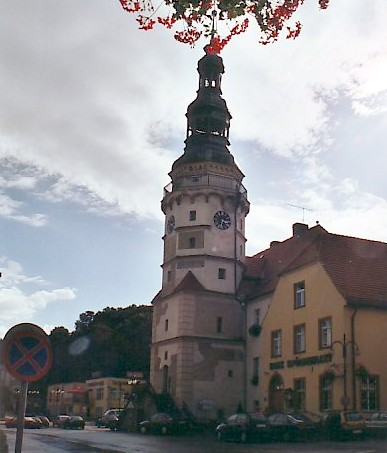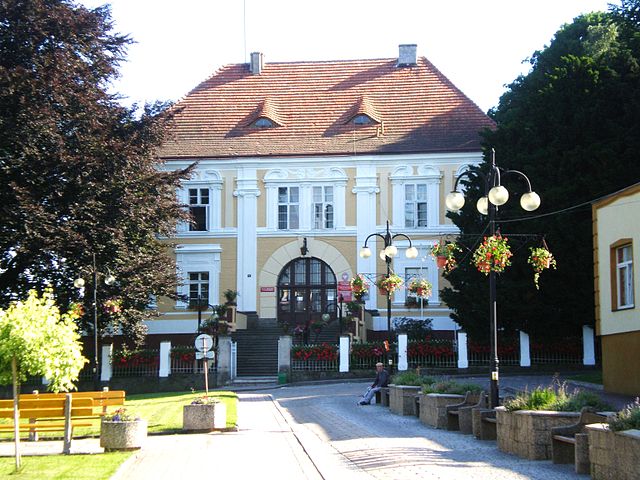Otmuchów
The Zamek Dolny Palace, currently the seat of the city administration. – Photo by: Pitcairn2424, Urząd Miasta in Gminy w Otmuchowie, CC BY-SA 3.0
Distance
53 km NV, 65 km NE, 32 km SE, 60 km NE, 43 km V, 68 km E, 12 km E, 67 km NE, 13 km V, 40 km SE, 57 km NV, 100 km NV, 37 km NV, 32 km NV, 24 km SVPopulation
5.300 (2006)
Location and history
Otmuchów is beautifully situated between two lakes in the southwestern part of Opole County (Silesia). Immediately west of the urban area is Lake Otmuchów (Jezioro Otmuchowskie) and to the east Lake Nysa (Jezioro Nyskie). The lakes are connected by the river Nysa Kłodzka, which runs south around the urban area. This river comes from the southwest and runs through – or past – the towns of Bystrzyca, Kłodzko, Bardo, Paczków, Otmuchów – and on to the east and northeast: Nysa and Lewin Brzeski, after which it ends in Odra.
Otmuchów has one of the oldest castles in Silesia. Until 1810, the castle and town belonged to the Diocese of Wrocław. The city gained market town rights in 1347. In the 14th century. the city was surrounded by a wall. After numerous wars and fires, however, a large part of the buildings have been destroyed, and the rebuilt buildings have to some extent changed their appearance. Among other things. as a result of the devastation of the war, the city lost some of its importance in favor of the neighboring town of Nysa, which was once the capital of the diocese.
It is believed that even before the introduction of Christianity into Poland, there was a Slavic settlement on the site. When the Diocese of Wrocław emerged in the year 1000, Otmuchów became the bishop's property – as well as other nearby towns. This is mentioned in a bun from Pope Hadrian IV in 1115, which is incidentally one of the oldest documents dealing with Silesian history. Here, 15 bourgeois districts are mentioned as belonging to the Diocese of Wrocław and including Otmuchów. The castle as well as surrounding properties are referred to as the direct property of the bishop. It is known that in 1261 there was a bailiff in Otmuchów, which included both judicial and tax collection. In 1428, the city was conquered and looted by the Hussites. A new attack followed in 1430, whereby the castle fell into the hands of the house-sitters. After that, both the castle and the city wall had to be rebuilt. The Thirty Years War (1618-1648) brought new destruction; only after this war did a boom flourish for the city. The castle was the episcopal seat and the church was again given the rank of diocese. Bishop Franciszek Ludwik (1683-1732) built a new Baroque church, named after Saint Nicholas (Mikołaj), and the castle was rebuilt. Many artists were invited to the city to work here. During the Silesian wars, in 1741, Otmuchów was captured by Prussian forces. The war brought bombings and destruction. As a result of the Silesian wars, the city came under Prussian rule. The secularisation, carried out after a decree of 1810, meant the end of the diocesan administration in the city. In 1820, the city of Otmuchów, with the castle, was handed over as a gift to the statesman Wilhelm von Humboldt, and the city remained on the hands of this family until 1924. In the second half of the 19th century. there was some industrial development in the town, thus a sugar factory emerged, incidentally the largest in Upper Silesia; the factory underwent a modernization in 1924. A major barrier was erected at the town from 1928-33. From 1945, Otmuchów belonged to the Polish state. After the war, the city mainly focuses on tourism and industry.

Otmuchów City Hall
Tourist attractions
The main sights of Otmuchów are the castle, which is located on its castle bank dominates the area. On a nearby bank stands the beautiful Baroque church from the end of the 17th century. In the square you can see the town hall from the 16th century. The largest industrial enterprise is the sugar factory, built in the 19th century.
Bispeborgen (Bishop Zamek)
The castle is the landmark of the city and a symbol of the city's long-standing connection with the diocese of Wrocław. The castle and castle park are located in the southern part of the city, near the river. The castle was built in stone in the 13th century. at the site of a former fortification, but was subsequently rebuilt several times. Thus, in 1585-96, the castle was rebuilt in the Renaissance style, a project led by Bishop Andreas von Jerin. The buildings were subsequently renovated following the damage that occurred during the Thirty Years' War and the First Silesian War. After Wilhelm von Humboldt took over the property, the interior of the buildings was renewed. In 1935 the city decorated the impressive castle for tourist purposes.
In the castle park are two bishopric pleasure castles, both from the beginning of the 18th century; one is referred to as a hunting castle; about the second castle see below: Zamek Dolny.
Zamek Dolny (Barbican)
This mansion, called Zamek Dolny, ie. The castle, or just Pałac (Castle), is one of the two episcopal pleasure castles in the city. The mansion was built in Baroque style in 1706-07 – after drawing by Nysa architect Michael Klein, and it was the residence of Bishop Franciszek Ludwik. Today it holds the municipal administration.
diocese Church
This church, dedicated to St. Nicholas, is first mentioned in the 14th century, but the Gothic building was destroyed during the attacks of the Hussites. It was not until 1691-93 that a reconstruction was possible. It now became a Baroque church with two towers. The interior of the church is one of the most beautiful church interiors in Silesia. The high altar was created by Johann Weinmann and Michael Willmann. The ceiling paintings are done by Karl Dankwart. The Church of Stifts is located west of the square.
City Hall (Ratusz)
Otmuchów Town Hall is one of the most beautiful Renaissance council houses in Silesia. The history of the building dates back to the 14th century. After the destruction of the housesites in the city, Bishop Jakob von Salza financed a reconstruction of the town hall in 1537. In 1575 the building was provided with a large sundial. The tower was added in 1604.
Spurvetårnet (Wieża Wróbla)
Spurvet Tower is a remnant of the former city wall. Originally, there were 3 city gates with gate towers in connection with the wall: Brama Młyńska to the south, Brama Grodkowska to the north and Brama Nyska to the east. The preserved gate tower, Wieża Wróbla, stood at the Nysa gate. The tower was built in the second half of the 14th century. and in 1566 was provided with a beautiful Renaissance-style attic. The tower, in its time, also served as the city's house of arrest.
Saint Anna’s Church
Where the church now stands, in the Middle Ages there was the city hospital and a chapel. In 1895 a new neo-Gothic church was erected, serving as a cemetery chapel.
Surrounding Area
Otmuchów Lake (Jezioro Otmuchowskie)
The lake, located just west of town, beautifully located in the countryside, is a water reservoir that was established in 1928-33 and covers approx. 2,000 ha. There are several holiday centers around the lake, which have good sandy beaches and many landing places. On the lake you can practice all kinds of water sports; Incidentally, the lake is known in angling circles as a good fishing spot, especially fishing of sand species.
Accommodation
Booking.com
Gmina Otmuchów (The official site of the city) – here also practical information for tourists
Other Internet sites and sources
Gmina Otmuchów (Town official page)
otmuchow.info (Versions in Polish, German and Czech)
Printed literature:
Otmuchów. Szkice do portretu miasta. By Marek Sikorski and Mirosław Grudzień. Otmuchów, 1995.
Translated into English by Google Translate. Spangshus.dk accept no liability for any errors or omissions in translation.
Map

Rating
Search
Most used tags
churches (205) Castles (86) Monasteries (79) Town walls (74) Lakes (71) Town halls (67) Rivers (65) Castles1 (62) Mansions (55) Museums (51) Regional museums (38) Town gates (36) Abbey churches (35) Castle ruins (30) Cathedrals (26) Forests (25) Health resorts (24) Mounds (23) Water sports (23) National parks (22)Click for all tags
Denne side er også tilgængelig på dansk. This page and contents is (c) Copyright 2018- www.spangshus.dk. Based on Inviator software by ISCA Software
